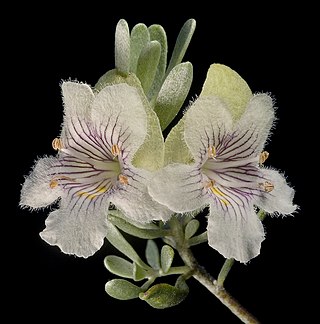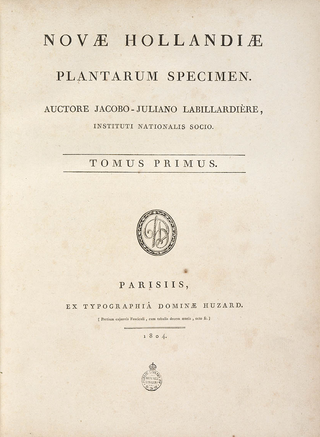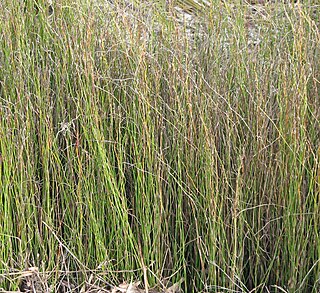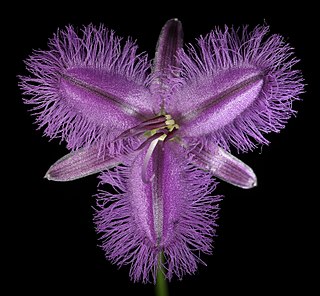
Jacques-Julien Houtou de Labillardière was a French biologist noted for his descriptions of the flora of Australia. Labillardière was a member of a voyage in search of the La Pérouse expedition. He published a popular account of his journey and produced the first Flora on the region.

Prostanthera, commonly known as mintbush or mint bush, is a genus of about 100 species of flowering plants in the mint family Lamiaceae, and all are endemic to Australia. Plants are usually shrubs, rarely trees with leaves in opposite pairs. The flowers are arranged in panicles in the leaf axils or on the ends of branchlets. The sepals are joined at the base with two lobes. The petals are usually blue to purple or white, joined in a tube with two "lips", the lower lip with three lobes and the upper lip with two lobes or notched.

Actinotus is a genus of flowering plants in the family Apiaceae, subfamily Mackinlayoideae, with about 18 species. It is native to Australasia. Its best known member is the flannel flower, a common sight in Sydney bushland in the spring. The generic name, meaning "furnished with rays" is derived from the Greek stem aktin-/ακτιν- "ray" or "sunbeam".

Podolepis is a genus of flowering plants in the tribe Gnaphalieae within the family Asteraceae. It is endemic to Australia and can be found in every state.

Calothamnus is a genus of shrubs in the family Myrtaceae and is endemic to the south-west of Western Australia. The common names one-sided bottlebrush or claw flower are given to some species due to their having the flowers clustered on one side of the stem or because of the claw-like appearance of their flowers. Calothamnus species are generally medium to tall woody shrubs with crowded leaves. In most species the leaves are crowded and linear in shape, and the flowers are usually arranged in dense clusters. The petals are small and fall off the flower soon after it opens but the stamens are long, numerous and usually bright red.

Actinotus helianthi, known as the flannel flower, is a common species of flowering plant native to the bushland around Sydney. It was named and first described by the French botanist Jacques Labillardière in his Novae Hollandiae Plantarum Specimen the first general flora of Australia. According to historian Edward Duyker Labillardière could not have collected the type specimen personally and might have received it from Jean-Baptiste Leschenault de La Tour botanist on the expedition of Nicolas Baudin or another early French visitor to New South Wales.

Anthocercis, commonly known as tailflower, is a genus of shrubs which are endemic to southern temperate Australia with the center of distribution in the South West Botanical Province of Western Australia. All species of Anthocercis contain tropane alkaloids, and have occasionally caused poisoning in children or been suspected of poisoning stock. Anthocercis is known as the only Solanaceous plant known to produce resin compounds on glandular trichomes.

Calytrix is a genus of shrubs in the family Myrtaceae described as a genus in 1806. They are commonly known as starflowers. Calytrix are endemic to Australia, occurring in the.

Comesperma is a genus of shrubs, herbs and lianas in the family Polygalaceae. The genus is endemic to Australia. It was defined by the French botanist Jacques Labillardière in his 1806 work Novae Hollandiae Plantarum Specimen. The genus name is derived from the Ancient Greek words come ("hair") and sperma ("seed"), and relates to the seeds bearing tufts of hair. The genus is distributed over southern Australia, particularly in the southwest of Western Australia, where 19 species are found. 24 species have been described.

Brachyscome ciliaris, commonly known as variable daisy, is a small bushy perennial herb with a prominent flower, which occurs throughout most of temperate Australia

Novae Hollandiae Plantarum Specimen is a two-volume work describing the flora of Australia. Facsimiles of the originals can be found in the online Biodiversity Heritage Library (Vol.1) and Vol 2).

Lepyrodia is a plant genus in the family Restionaceae, described as a genus in 1810.

Myriocephalus is a genus of Australian flowering plants in the family Asteraceae.

Comesperma volubile, commonly known as love creeper, is a slender climber in the family Polygalaceae. It is a twining plant with linear leaves and pea-like blue flowers.

Chrysocephalum apiculatum, known by the common names common everlasting and yellow buttons, is a perennial herb native to southern Australia. It is a member of the Asteraceae, the daisy family. The name "everlasting" was inspired by its use as a long-lasting cut flower. It is increasing in popularity in Australia as a cottage garden plant, but is still not well known.
Calorophus is a group of plants in the Restionaceae described as a genus in 1806. The entire genus is endemic to Australia, found in the States of Victoria and Tasmania.

Comesperma calymega, commonly known as blue-spike milkwort, is a slender herb in the family Polygalaceae. It is a perennial herb growing to between 10 cm and 50 cm high, from a short woody rhizome.

Comesperma virgatum, commonly known as milkwort, is a herb in the family Polygalaceae. It is an erect slender herb growing to between 30 cm and 1.6 m high, on sandy and lateritic soils, and sometimes in swampy conditions. Its pink to purple flowers may be seen from September to December or January to March.

Thysanotus dichotomus is a herb in the Asparagaceae family, endemic to Western Australia, and first described in 1805 by Jacques Labillardière as Ornithogalum dichotomum. In 1810, Robert Brown transferred it to the genus, Thysanotus.

Siloxerus humifusus is a species of plant in the tribe Gnaphalieae within the family Asteraceae native to Western Australia. It was first described in 1806 by Jacques Labillardière.



















